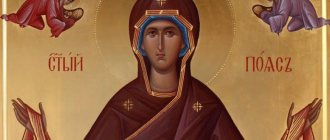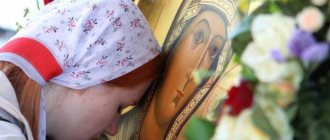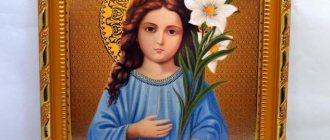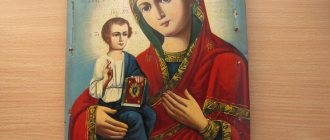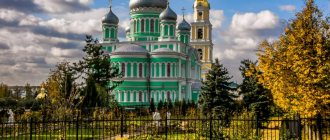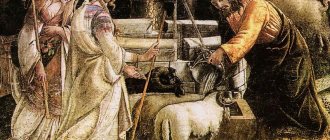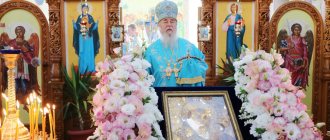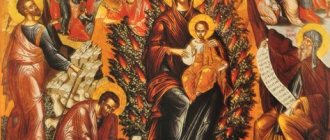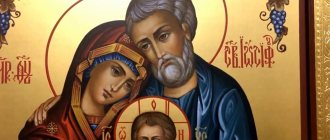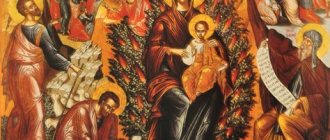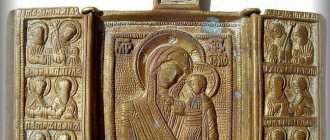All women by nature have a basic mission - giving birth to a child. But there are situations when you can’t become a mother. There may be various reasons for this, which are not always related to health status. It happens that both spouses are healthy, but conception itself does not occur. And at that moment the most important thing is not to give up, but to believe in a miracle. Many women do this. In an effort to find a child, they read prayers and also look for the Belt of the Virgin Mary. Many say that the miracles of the Belt of the Virgin Mary include the ability to conceive a child, preserve pregnancy, and promote a successful delivery.
The meaning of the belt of the Blessed Virgin Mary
The appearance of the shrine is associated with apocryphal sources and holy tradition recorded by the church fathers. According to legends, the belt of the Virgin Mary, after her dormition and ascension into heaven, was given to two pious Jerusalem widows, who passed it on to their descendants.
According to Catholic tradition, the shrine passed into the hands of the Apostle Thomas, who was late for the burial of Mary, but was rewarded with a vision of her. In Israel, the relic was kept for centuries, until the Roman emperor took the find to Constantinople, to the Chalcopratian Church.
The gift, kept in a specially equipped precious ark, was an important value for the rulers of the Eastern Roman Empire. According to written sources, the wife of Emperor Leo VI, who ruled at the turn of the 10th century, Zoe, with the help of the relic, got rid of the evil spirit that tormented her. The possessed empress had a dream in which Divine powers told her to turn to the patriarch and venerate the shrine. When the command was fulfilled, Zoya recovered.
After the incident, the relic was transferred to the Blachernae Temple. The imperial couple ordered prayers of thanksgiving to the Mother of God to be served. The shrine itself acquired an even more significant status, confirming its miraculous nature. In honor of the discovery, a solemn canon was written. This event was depicted on ancient icons.
Nowadays, parts of the relic are stored in several places. For example, on Mount Athos, in the Vatopedi monastery. A complete copy, inherited, according to legend, from the Apostle Thomas, is kept in Turkey, in Homs. Smaller details of the shrine can be found in Europe, Georgia and Russia.
This artifact has very important religious significance because healing comes from it. It is believed that even his image carries spiritual protection and help. Therefore, Orthodox Christians strive to acquire icons dedicated to the shrine.
The Miracle of the Belt
| People stand in line at the Cathedral of Christ the Savior, waiting for the Belt of the Blessed Virgin Mary, which will be delivered to the temple from the Greek Vatopedi Monastery on Mount Athos. © Vitaly Belousov/RIA Novosti |
Moscow - and all of Russia - in recent days have been witnessing a phenomenon that pleases some, leaves others bewildered, openly angers others, and makes others think.
Hundreds of thousands of people from all over the country spend twenty hours standing in the cold to touch one of the greatest shrines of the Orthodox world - the belt of the Virgin Mary. These are men and women, young and old, many with children; They behave very calmly and quietly, but their behavior is a very serious challenge to the entire modern society.
These are people who, in a world obsessed with convenience, are willing to endure very significant inconveniences. Those who are willing to spend long hours - and dozens of hours - in the cold and cramped conditions. Past billboards offering various ways to increase your comfort and in every possible way “to pamper your white, loose, crumbly body,” a line of people slowly moves forward who, in the words of the Apostle, “pacify and enslave their body” (1 Cor. 9:27). Past the sparkling storefronts, where efficient salespeople rush to serve capricious customers at a moment's notice, passes a procession of people who are ready to endure and humble themselves in order to get closer to the Shrine. Among the world, absorbed by one passion - to earn and spend money - there are people who are ready to endure hardship and labor for the sake of what is not convertible into dollars and euros, things and pleasures.
The world looks at them with bewilderment - how can this be? Who pays these extras? Nobody? The richest people in the country would not have enough money to hire these hundreds of thousands of people for these many hours. Political activists can only gather very small groups of supporters - and none of them dares to dream of hundreds of thousands of people who would go out into the cold for them.
We saw how in Arab countries many people took to the streets - but these were unrest and revolutions, the crowds were overwhelmed with despair, anger and hatred, they went to fight and kill. And even where unrest is still far away, large crowds on the streets, mass processions, are always accompanied by some kind of outrage - smashing of windows, burning of cars. Recently we saw crowds of Britons going out to loot shops in their towns. Usually crowds on the streets are a rather frightening phenomenon.
But this is not what we see now. Hundreds of thousands of Russian people on the streets of Moscow and other cities walk meekly and peacefully, humbly and patiently, with quiet joy and hope. It must be noted that we are witnessing something extremely unusual; let's call a spade a spade - a miracle. Manifestations of God's grace in our fallen world.
And as happens with miracles, some are convinced and believe with trepidation, others look for “natural” - natural for them - explanations. Some believe that people stand in the hope of receiving “supernatural medicine.” Jesus said to her, “Did I not tell you that if you believe, you will see the glory of God?” So they took away the stone [from the cave] where the dead man lay. Jesus raised his eyes to heaven and said: Father! I thank You that You heard Me. I knew that You would always hear Me; but I said [this] for the people standing here, so that they might believe that You sent Me. Having said this, He cried out with a loud voice: Lazarus! get out. And the dead man came out, entwined on his hands and feet with burial cloths, and his face was tied with a scarf. Jesus says to them: Untie him, let him go. Then many of the Jews who came to Mary and saw what Jesus had done believed in Him. And some of them went to the Pharisees and told them what Jesus had done. (John 11:40-46)"
We do not know what those who did not believe told themselves and each other - perhaps they convinced themselves that there was some kind of trick and forgery, that Lazarus lay pretending to be dead and covered with something rotten for the smell. We do not know how these people deceived themselves; people both then and now are extremely inventive in self-deception. But those who did not bother coming up with excuses believed. And today we see how Russia, about which many spoke - some with satisfaction, some, on the contrary, with sorrow, that it “already stinks” - is called out of its grave by the voice of God’s grace.
Some people are confused by the very veneration of relics. But the Holy Church is a family, and in a family there is nothing more natural than relics. With what excitement some families pass on objects that belonged to their great-grandfather, his grandfather, or even more distant ancestors! Heirlooms make family history alive and tangible. This is the same for the Church - everything that belongs to the saints, that bears the stamp of their presence, is dear to the heart of a Christian. This is especially true when we are talking about a relic related to the One whom Orthodox Rus' reveres with infinite love and reverence, our Most Holy Lady Theotokos.
Someone does not believe that a material object can be involved in the grace of God; but there are examples of this already in Scripture: “God performed many miracles through the hands of Paul, so that handkerchiefs and aprons from his body were placed on the sick, and their illnesses ceased, and evil spirits came out of them. (Acts 19:11,12)"
Someone reproaches people who go to the Belt of the Virgin Mary that their faith is perhaps not lofty enough, that they are looking for help in something earthly - in childbearing, in gaining health, in family life. But is there anything wrong with seeking God’s help in all these good and useful things? After all, at every Liturgy we ask for our earthly needs. Maybe—surely, there are different people standing there—some of them lack theological knowledge. Well, this is a fixable matter - if only there was a desire, a heartfelt turn to the Lord, a search for His mercy. And people who are ready to endure long hours of waiting in order to touch the Shrine have all this. Let us thank the Lord and His Most Pure Mother for the wonderful mercy shown to us.
Description of the icon “Position of the Honorable Belt of the Blessed Virgin Mary”
In Russia, the Mother of God is revered as a heavenly patroness and intercessor, so the legends telling about the earthly life of the Virgin Mary and the miracles associated with Her found a great response in the hearts of people. Perhaps this is why the story of the miraculous discovery of the Mother of God’s belt appears quite often in icon painting. You can find ancient examples with this image in Novgorod, in the Kirillo-Belozersky Monastery and other places.
As a rule, they depict a scene of the relic being placed in a golden ark, on the throne of a large church, in front of the image of the Virgin Mary. The richly dressed emperor and priests surround the throne and, with prayerful gestures, thank the Lord for acquiring this gift. The techniques used differ depending on the period and place where the icon was created. Sometimes the robe of the Mother of God is mentioned along with the belt.
Another type of image associated with the shrine is the Belt of the Blessed Virgin Mary. Here the Queen of Heaven herself holds in her hands a red belt embroidered with gold. The image is very close to the iconographic type of the Veil, but they have different meanings. “The Protection of the Virgin Mary” is rather a symbolic image, while the Honest Belt is a real historical shrine, famous for many miracles.
In any case, over the centuries, the legend of the shrine and its images have been of great importance to Christians. For some people, Divine help granted through touching the gift of the Mother of God, or at least its iconographic image, remained the only hope for deliverance from suffering. History knows many legends associated with the artifact.
Prayers
Troparion of the Position of the Honorable Belt of the Blessed Virgin Mary
voice 8
Ever-Virgin Mother of God, covering of men,/ the robe and girdle of Thy most pure body,/ Thou hast granted sovereign taxation to Thy city,/ by Thy seedless Nativity, incorruptible,/ for Thy nature is renewed and time is renewed./ In the same way, we pray to Thee to grant peace to Thy city/ and to the souls to our great mercy.
Kontakion of the Venerable Belt of the Blessed Virgin Mary
voice 2
Your God-pleasing womb, Mother of God,/ Your generous, honorable belt/ the power of Your city is unconquerable/ and the treasure of good things is endless,/ the only one who gave birth to the Ever-Virgin.
Kontakion of the Venerable Belt of the Blessed Virgin Mary
voice 4
The honorable belt of Thy position/ is celebrated today by Thy, Thrilling Temple/ and diligently calls upon Thee:/ Rejoice, O Virgin,/ praise to Christians.
How does an image help?
Legends tell about miracles associated with the Belt of the Mother of God. The legendary case of the deliverance of Empress Zoya from demons was not the only one in a series of Divine mercies bestowed on people. First of all, icons depicting a shrine help in healing diseases. The Mother of God can cure both physical and mental illnesses of a person.
However, images of relics have particular power in matters related to childbirth. Since the Middle Ages, the tradition of praying in front of the image of the shrine has been preserved to facilitate childbirth. Even some noble aristocrats took advantage of this opportunity and girded themselves with laces prayed before the Honest Belt in order to safely be relieved of their burden.
In addition to helping with birth, the shrine also helps in cases of infertility. The Mother of God, with her merciful intercession, helps women become mothers. Therefore, priests often recommend turning to the described icons to achieve the happiness of motherhood.
In general, the appearance of the image of the Virgin Mary with the Honest Belt in the house will protect the inhabitants from sudden dangers, adversities and difficulties. The icon will help preserve the peace of the hearth and the strength of faith. It is not forbidden to turn to Our Lady every day. According to the words of the Lord, “Ask and you will receive,” even when faced with a hopeless situation, people do not need to despair. Pure faith, repentance, and humility can appease Heaven and grant what is desired. This is why prayer is so important in Christianity.
Reverence
Pilgrims are constantly heading to Vatopedi, letters are arriving. They go to pieces of the shrine stored in different countries.
Service at the Vatopedi Monastery
People have great faith in the gracious power of the belt of the Blessed Virgin Mary. And indeed, miracles occur continuously - in spite of all diagnoses, infertile people conceive, the lame and crippled are healed, the mentally ill gain health, drunkards and drug addicts leave their addictions. There are no number of miracles that occurred during a difficult pregnancy or difficult childbirth. As a sign of gratitude, warmed by the miraculous help of the Queen of Heaven, Christians send letters and photographs of children as evidence of the miracle.
